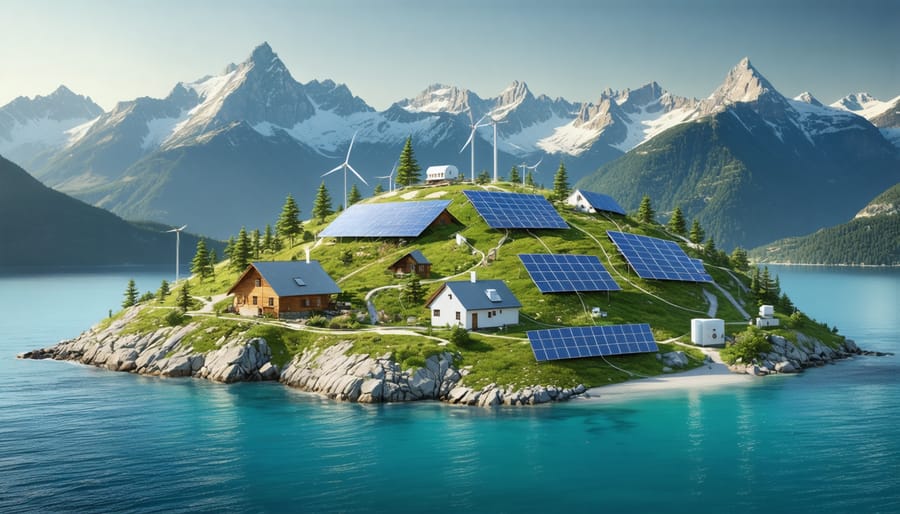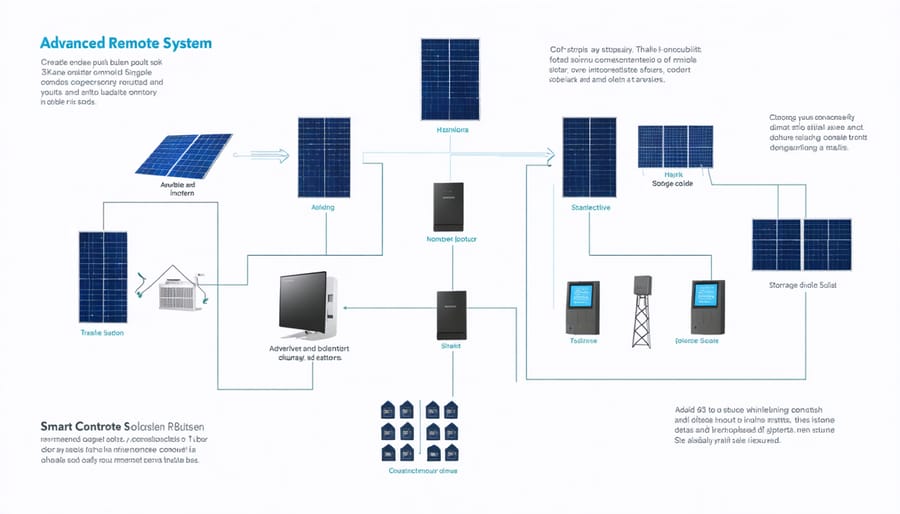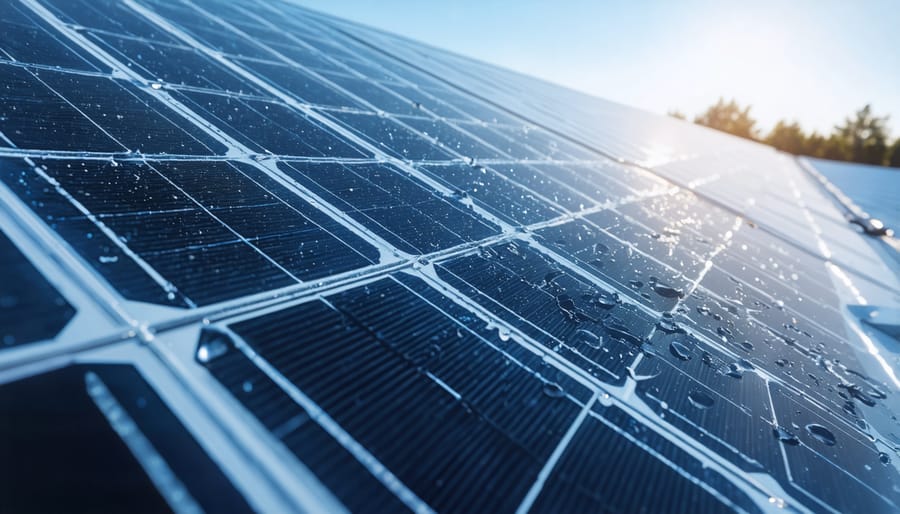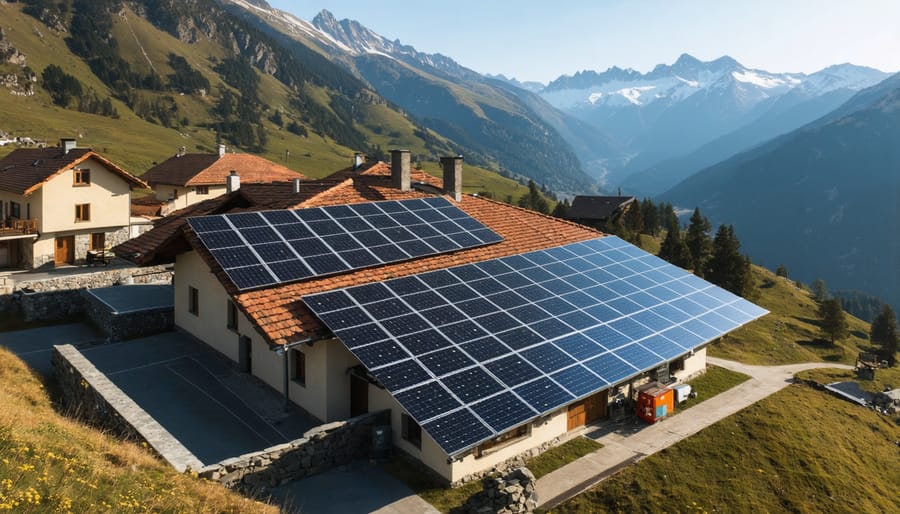How Advanced Solar Integration is Transforming Europe’s Remote Communities

Transform remote locations into sustainable power hubs through advanced integrated solar systems, the next evolution in off-grid solar solutions. These sophisticated installations merge cutting-edge photovoltaic technology with smart energy management systems, delivering reliable power even in Europe’s most challenging environments.
Modern integrated solar represents a quantum leap beyond traditional panels, incorporating adaptive tracking systems, advanced energy storage solutions, and intelligent load management. From isolated Alpine research stations to remote Mediterranean islands, these systems are revolutionizing how we power facilities beyond the grid’s reach.
As European energy demands evolve and grid independence becomes increasingly vital, advanced integrated solar systems offer a compelling blueprint for sustainable power generation. These installations achieve remarkable efficiency rates of up to 40% higher than conventional solar setups, while sophisticated monitoring platforms ensure optimal performance in real-time.
This fusion of innovation and practical engineering doesn’t just provide power – it creates entirely self-sufficient energy ecosystems that adapt to changing environmental conditions and usage patterns. For organizations and communities seeking true energy autonomy, advanced integrated solar represents the gold standard in renewable power generation.
The Evolution of Remote Solar Integration
Smart Grid Technologies
Modern remote solar installations rely heavily on smart grid technologies to maintain optimal performance and reliability. These sophisticated management systems integrate advanced monitoring, automation, and control capabilities that enable remote locations to operate efficiently without constant on-site supervision.
At the heart of these systems are intelligent controllers that continuously analyse power generation, storage levels, and consumption patterns. Real-time data monitoring allows for immediate response to changing conditions, ensuring stable power supply even in challenging environments. The systems automatically adjust power distribution based on demand, weather forecasts, and battery status.
European innovations in grid management have introduced self-healing capabilities, where systems can detect and isolate faults, rerouting power to maintain service continuity. Advanced metering infrastructure (AMI) provides detailed insights into system performance, enabling predictive maintenance and optimised energy management.
These smart systems also facilitate seamless integration with existing power infrastructure when available, creating hybrid solutions that maximise reliability while minimising operational costs. For completely off-grid installations, intelligent load management ensures critical systems receive priority during periods of reduced generation.
Advanced Storage Solutions
Modern advanced storage solutions have revolutionised the potential of integrated solar systems, offering unprecedented reliability and efficiency. At the forefront are intelligent lithium-ion battery systems, featuring sophisticated battery management systems (BMS) that optimise charging cycles and extend operational lifespans.
European innovations in flow battery technology present exciting possibilities for large-scale storage, particularly in industrial applications. These systems can store massive amounts of energy with minimal degradation over time, making them ideal for seasonal energy management.
Thermal energy storage systems, increasingly popular in Nordic countries, complement traditional battery storage by capturing excess solar energy as heat. This stored thermal energy can then be used for space heating or industrial processes, maximising system efficiency.
Smart grid integration capabilities now allow these storage systems to participate in grid balancing services, creating additional value streams for system owners. Combined with AI-powered predictive analytics, modern storage solutions can anticipate energy demands and optimise charging patterns based on weather forecasts and consumption habits, ensuring optimal energy utilisation throughout the year.

Key Components of Advanced Remote Solar Systems
High-Efficiency Solar Panels
Recent innovations in solar panel technology have revolutionized performance in challenging environments, particularly across Europe’s diverse climate zones. New-generation panels featuring bifacial technology can capture sunlight from both sides, increasing energy yield by up to 30% in optimal conditions. These panels incorporate advanced anti-reflective coatings and enhanced cell architectures that maintain high efficiency even during overcast days.
Temperature-resistant designs now enable consistent performance in extreme conditions, from Nordic winters to Mediterranean summers. The latest modules feature improved thermal management systems that minimize efficiency losses in high temperatures, while specialized glass treatments prevent snow and dust accumulation.
European manufacturers have pioneered panels with self-cleaning properties and enhanced durability against salt spray, making them ideal for coastal installations. Multi-junction cells, combining different semiconductor materials, achieve conversion efficiencies exceeding 25% – a significant improvement over traditional panels.
These technological advances, coupled with smart monitoring systems, ensure optimal performance in low-light conditions and reduce maintenance requirements, making solar installations more viable in previously challenging locations.
Intelligent Control Systems
Modern integrated solar systems incorporate sophisticated control mechanisms that revolutionize how we manage solar energy production and consumption. These intelligent systems continuously monitor performance parameters, weather conditions, and energy demands to optimize system efficiency in real-time.
At the heart of these control systems are smart inverters and energy management platforms that seamlessly coordinate multiple components. They analyze data from various sensors, adjusting power flow between solar panels, storage systems, and the grid to maximize energy yield while minimizing waste. For European installations, these systems are particularly valuable in managing seasonal variations in solar production.
Advanced monitoring solutions provide system owners with detailed insights through user-friendly interfaces, accessible via smartphones or computers. Users can track energy production, consumption patterns, and system health, while automated alerts notify them of any maintenance requirements or potential issues before they become problematic.
The integration of artificial intelligence and machine learning algorithms enables predictive maintenance and performance optimization. These systems learn from historical data and weather forecasts to make intelligent decisions about energy storage and distribution, ensuring reliable power supply even during challenging conditions.
For businesses and homeowners, these intelligent controls translate into reduced operational costs and enhanced system reliability, while contributing to Europe’s renewable energy goals.
Weather-Resistant Infrastructure
Modern integrated solar systems are engineered to withstand Europe’s diverse and sometimes harsh weather conditions. Advanced materials and robust design elements ensure reliable performance across varying climates, from Nordic snowfall to Mediterranean heat waves.
The latest solar installations feature reinforced glass panels with specialized coatings that resist impact from hail and debris while maintaining optimal light transmission. These panels undergo rigorous testing to meet European standards for wind resistance, capable of withstanding speeds up to 140 km/h in most installations.
Innovative mounting systems incorporate flexible components that allow for thermal expansion and contraction, preventing stress damage during extreme temperature fluctuations. The electrical components are housed in IP65-rated enclosures, protecting critical systems from dust and water ingress in all weather conditions.
Cutting-edge drainage systems prevent water accumulation, while snow-shedding designs enable panels to self-clear during winter months. Anti-corrosion treatments and marine-grade materials ensure longevity in coastal areas where salt spray can be particularly challenging.
These weather-resistant features contribute to system longevity, with many installations maintaining peak performance for 25+ years despite exposure to harsh conditions. This durability translates into better return on investment and reduced maintenance requirements for property owners across Europe.

Implementation Success Stories
Alpine Communities
The Swiss village of Zermatt exemplifies how advanced integrated solar systems can transform energy consumption in challenging alpine environments. This car-free mountain community, situated at 1,620 meters above sea level, has successfully implemented a comprehensive solar integration project that powers both residential and commercial buildings while preserving its pristine environment.
The installation combines roof-mounted photovoltaic panels with innovative snow-resistant coating technology, ensuring optimal performance even during heavy snowfall. Strategic placement of panels at steeper angles prevents snow accumulation while maximizing exposure to winter sunlight. The system’s smart grid integration enables efficient energy distribution throughout the village, with excess power stored in advanced battery systems for use during periods of limited sunlight.
What makes Zermatt’s implementation particularly noteworthy is its dual-purpose design. The solar installations serve as both power generators and snow barriers, protecting buildings from avalanche risks while producing clean energy. The project has reduced the village’s carbon footprint by 60% since implementation, while maintaining reliable power supply throughout the year.
Local businesses, including hotels and ski facilities, report significant reduction in energy costs, with some establishments achieving near energy independence during peak summer months. This successful integration demonstrates how advanced solar solutions can be adapted to meet the unique challenges of high-altitude communities while preserving their natural and cultural heritage.

Island Installations
European islands have emerged as pioneers in advanced integrated solar implementation, showcasing remarkable success stories in community energy independence. The Greek island of Tilos stands as a prime example, having transformed its energy infrastructure with a sophisticated solar-battery system that now powers over 400 households year-round. This installation combines 13,000 square meters of solar panels with advanced storage solutions, effectively meeting 85% of the island’s energy needs.
Similarly, the Portuguese Azores archipelago has embraced innovative solar integration, with São Miguel Island implementing a smart grid system that coordinates solar generation with existing geothermal resources. This hybrid approach has reduced diesel consumption by 65% while maintaining stable power supply for its 140,000 residents.
Croatia’s Cres Island demonstrates how advanced solar can complement tourism-dependent economies. Their installation features building-integrated photovoltaics across hotel complexes and public buildings, generating 2.3 MW of power while preserving the island’s aesthetic appeal. The system incorporates smart monitoring technology that adjusts output based on seasonal tourism fluctuations.
These installations prove that remote locations can achieve remarkable energy autonomy through thoughtful solar integration, serving as blueprints for other European communities seeking sustainable power solutions.
Future-Proofing Remote Solar Solutions
Upcoming Innovations
The solar energy landscape is poised for remarkable transformations, with several groundbreaking innovations on the horizon. Perovskite solar cells are emerging as a game-changer, promising higher efficiency rates while significantly reducing production costs. European researchers are making substantial progress in developing these next-generation cells, which could achieve efficiency rates above 30% when combined with traditional silicon cells.
Floating solar installations are gaining momentum, particularly in countries with limited land availability. These innovative systems are being enhanced with smart tracking capabilities and wave-resistant designs, making them increasingly viable for Europe’s numerous inland water bodies and coastal areas.
Building-integrated photovoltaics (BIPV) are evolving beyond simple roof tiles to include entire solar facades and windows. New developments in transparent solar technology could transform every glass surface into a potential power generator while maintaining aesthetic appeal and natural lighting.
Storage solutions are also advancing rapidly, with solid-state batteries and hydrogen storage systems showing promise for long-term energy management. European manufacturers are developing intelligent hybrid systems that seamlessly integrate multiple storage technologies with solar installations.
Additionally, artificial intelligence and machine learning are being incorporated into solar management systems, optimizing energy production and distribution while predicting maintenance needs with unprecedented accuracy. These smart systems will be crucial for maximizing the efficiency of future solar installations across Europe’s diverse climate zones.
Maintenance and Longevity
Regular maintenance is crucial for maximising the performance and lifespan of advanced integrated solar systems. A well-maintained installation can operate efficiently for 25-30 years, with some components lasting even longer. Professional inspection schedules typically include quarterly visual checks and annual comprehensive assessments of all system components.
Key maintenance priorities include keeping solar panels clean from dust and debris, which can reduce efficiency by up to 15%. In European climates, self-cleaning systems and hydrophobic coatings help minimise manual cleaning requirements. Regular monitoring of inverter performance and electrical connections ensures optimal energy conversion and system safety.
Modern integrated systems feature smart monitoring capabilities that alert owners to potential issues before they become serious problems. These predictive maintenance tools analyse performance data in real-time, helping to prevent unexpected downtime and extend system life.
To ensure longevity, it’s essential to:
– Monitor system performance metrics regularly
– Keep detailed maintenance records
– Address minor issues promptly
– Use only certified replacement parts
– Schedule professional inspections at recommended intervals
Professional maintenance contracts often include emergency response services and performance guarantees, providing peace of mind for system owners. Many European installers offer comprehensive care packages that combine routine maintenance with performance monitoring and system optimisation services, ensuring maximum return on investment throughout the system’s lifetime.
Advanced integrated solar solutions have proven transformative for remote areas across Europe, demonstrating remarkable potential for sustainable energy independence. From isolated Alpine communities to remote Mediterranean islands, these systems have consistently delivered reliable power while reducing environmental impact and operational costs. The successful integration of smart monitoring, storage solutions, and hybrid capabilities has created resilient energy ecosystems that serve as models for future deployments.
Looking ahead, the trajectory for advanced integrated solar in remote locations appears exceptionally promising. Technological innovations continue to enhance system efficiency and reliability, while decreasing installation and maintenance costs. The evolution of energy storage solutions and smart grid technologies is making these systems increasingly viable for even the most challenging locations.
The European Union’s commitment to renewable energy transition further strengthens the case for advanced integrated solar in remote areas. With targeted funding initiatives and supportive policies, more communities can access these sustainable energy solutions. The growing network of skilled installers and maintenance professionals across Europe ensures long-term system viability and optimal performance.
As climate change concerns intensify and energy security becomes increasingly critical, advanced integrated solar systems represent not just an alternative, but a fundamental solution for remote areas. Their proven track record, combined with ongoing technological advancements and strong institutional support, positions them as a cornerstone of Europe’s sustainable energy future.
Leave a Reply